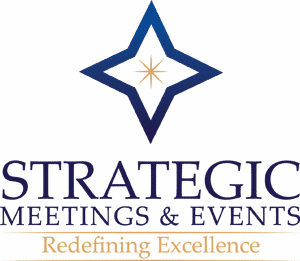10 Innovative Ways To Squeeze More From Your Event Budget
By Jeff Kear
Search the Internet for the phrase “event planning challenges” and you will find countless surveys and lists (like here and here) that name reduced event budgets or budget cuts as one of the top challenges facing event professionals every year.
 In fact, this is such a consistently recurring challenge and issue for meeting and event planners that many of us simply expect to do more with less at the onset of planning any event, and we’re almost astonished when someone says “Go for broke.”
In fact, this is such a consistently recurring challenge and issue for meeting and event planners that many of us simply expect to do more with less at the onset of planning any event, and we’re almost astonished when someone says “Go for broke.”
The Great Recession is at least partially to blame for this new norm. That was a period when conferences were being cancelled, meetings dramatically cut back and weddings put on hold, and since then clients and promoters have generally taken a more judicious and measured approach to event budgeting and spending.
Being the resourceful people we are, event pros have been adept at finding inventive solutions to event budget limitations because flexibility and problem-solving are two essential traits for succeeding in this business (and we have those traits in spades).
With that said, here are some inventive ways to make the most of your event budget and even expand it with some nifty strategies.
1. Craft a unique event theme and name
Nothing does more to grow your event budget than more attendees and more paid registrations (well, other than a wealthy benefactor or donor with bottomless pockets). And the first and possibly most important step in generating the awareness and interest you need is coming up with an event theme and name that turns heads.
“If you make the headline for your event sound more compelling, you can get more attendance by having the event be shared more and have a higher click-through rate on social media,” says author and event guru Alex Genadinik. “Cool sounding events can also get orders of magnitude more traffic from local event websites, which look for cool events to feature.”
The best place to start here is to survey your target audience for the timely topics that interest or even frighten them (negative headlines actually pull better than positive ones). Find out what they want to learn the most and where they fear they have gaps in their knowledge. Know their style and how they like to be entertained. And then serve it up with a title that will compel them to learn more.
Here’s a great post on writing headlines and names.
2. Book vendors and venues for multiple events
Long ago when I ran a marketing agency, I was accustomed to contracting with a vendor for a specific use on a specific project and then negotiating with them for that particular deal, hoping they would come down in price for the promise of more business from me down the road.
But what if I had brought two or more pieces of business to a vendor at the same time? This would have given me considerably more leverage in negotiating a better price for all my projects, making all my clients happy.
Taking this a step further, you could develop a deep relationship with a particular vendor and commit to them as your first choice, earning not only their loyalty but also a standing discount. Meghan McNeil from the One Line Agency in New York City concurs. “If there is a product you know you need for most events, stick to one vendor. Being a loyal client can really help when trying to save money. Most companies will price match as well if you find another vendor for cheaper, so do your research.”
3. Piggyback onto another event
In theory this is a great idea and it can save you thousands if executed properly. Yes, if two simultaneous events use the same menus, share catering/hospitality staff and may even share some common spaces, the venue and/or catering vendors probably realize cost savings that they can pass on to the event promoters/planners.
However, in practice this is much trickier. “The key to pulling this off is finding an event expert who has close relationships with those venues [and vendors],” says Karen Shackman of Shackman Associates New York. “Ordering high-end menus to optimize the attendee experience can be done if you work creatively with a hotel or event venue that accommodates more than one group at once. We recently worked with a luxury association convention group of 750 at a legacy New York City hotel where we piggybacked the food and beverage component for a major gala with the group of a similar size in an adjacent ballroom.”
As such, it’s always smart to stay connected with other event planners, professionals, vendors and venues in your area so that you can easily and effectively reach out to and collaborate with them for a strategy like this to work.
4. Focus on quality over quantity
Every business, organization or client wants a memorable event that makes attendees ooh and ahh and provides a premium experience across all variables (food, content, design, venue, etc.). However, many times you have clients with caviar tastes on a Taco Bell budget, and there simply isn’t the money for a plated dinner, world-class keynote speaker and Beyonce performing her hits.
The answer isn’t to try to do it all with mediocrity (obviously). Instead, focus on doing a few things extremely well, as Christy Lamagna of Strategic Meetings & Events explains.
“One instance of doing a lot with a little was an event where we planned a dessert reception in lieu of a dinner. Guests went to dinner on their own and were invited to return to the hotel for a dessert reception. Huge ice cream sundae bars, towers of cupcakes, warm cookies, glasses of whole and chocolate milk, hot chocolate stations with toppings and a chocolate fountain were just some of the sweet treats offered. We engaged their sense of smell, created a relaxed, fun, nostalgic mood. Guests are still talking about the evening, much more than they would be if we had offered a standard dinner.”
5. Negotiate contracts with ferocity
Cost savings are in the details, but if you don’t have a thorough understanding of what can be negotiated and how much, you are already playing from behind.
“We help our clients stay within their budget by being fierce negotiators,” says Annette Naif of Forté Events NYC. “We make it our focus to be extremely knowledgeable in what can be negotiated. For example, food and beverage minimums, attrition, room rates, concessions, deadlines, storage fees, cancellation policies, contract clauses to protect the client and much more. In addition, we advise on dates, times, locations that will save the client money based on our knowledge of those areas where vendors and venues tend to be more flexible.”
This does require you to be well versed in reading and deciphering contracts as well as knowing the pain points of vendors in your local market.
6. Use sweat equity to get free labor
Sweat equity is usually associated with startups that can’t afford to pay developers full salaries (or in some cases any salary) and so they offer company shares or ownership in exchange for labor.
However, events are like startups in many ways (don’t get me started), so why not offer people who can’t afford to attend a ticket in exchange for their labor at the event.
As Alex Genadinik explains, “One of the best ways to get free staff for your events is to exchange labor with people who can’t afford to pay for a ticket. There are always people who ask for free tickets, so instead of rejecting them outright, you can have them do a job in exchange for attendance, which will immediately provide a free workforce. These jobs can be collecting tickets, manning booths or other simple tasks for which you would have otherwise had to pay someone.”
You may want to draw up a short independent contractor agreement outlining the terms of hire for these free laborers and have them sign it so that there are no misunderstandings.
7. Reuse expensive materials or fixtures
We are in a reuse/repurpose/recycle age, so applying this strategy to event budgets and cost savings aligns perfectly with this trend. However, as event managers, we are often fixated on the event at hand and sometimes too busy to think about how the items we are buying for next month’s event can be reused/repurposed/recycled for next year’s event (or the next client’s event).
“One way we have tried to cut costs is reusing expensive materials,” confirms Meghan McNeil. “When hosting events that require large equipment, we have made sure that these items can be used over a broad spectrum of events. Purchasing things such as tents, frames and hardware – which we can reskin with new backgrounds and artwork – can make the item seem like a completely new piece of collateral, while saving money for the client and our agency.”
8. Using non-traditional venues
Lately, there has been reasonably high demand to host events at hotels, conference centers and reception halls, which if I recall my Econ 101 supply/demand curves correctly would drive up the costs of renting spaces at these venues (2016 event industry surveys actually bear this out).
So if the traditional venues are expensive and you don’t have as much money to lay out on your space, go to a secondary market where the demand is lower, which would be the non-traditional venue market. Museums, theaters, municipal buildings, libraries, zoos, parks, mansions/estates, historical buildings, gardens and ships all fit this category, as do some restaurants and bars.
Karen Shackman has found that Millennials in particular are fond of non-traditional venues. “They are seeking event venues away from legacy hotels that provide them a true New York City neighborhood vibe. This is leading meetings to book venues in hot areas like the Lower East Side. Using services like Uber and Lyft are ideal for reaching these neighborhoods with smaller streets that could delay groups of buses that are more expensive.”
9. Make items do double duty in a clever way
So let’s say you’ve booked that alternative, non-traditional venue but now have to decorate it and don’t have a budget for lots of backdrops, wall hangings, centerpieces, banners, drapes, etc.
Now is the time to get really creative with what you do have and make it do double-duty as decor. Use innovative lighting to flood walls and areas with color. Use food as centerpieces (like colorful fruit displays or bread towers). There are thousands of possibilities here … all it takes is some boundary-breaking thinking.
10. Sell something unique during registration and at the venue
Tickets, registrations and donations aren’t the only way to generate revenues from attendees. You can also develop a unique product to sell to people when they register or when they are on-site.
An example of this done effectively is the concert T-shirt. Sure, now they are ubiquitous and the idea seems like a total no-brainer. But at one time this idea was new, and they caught on because they are the perfect event product for two reasons: 1) they are of value to the audience (who wants a souvenir to show off their fan status) and 2) the price point and size are perfect for the occasion.
The key here is creating something of value to your audience, and it can be quite different from a t-shirt. “It can be food or other helpful items that people might need at the event,” says Alex Genadinik. “You can even do something innovative. For example, if people are looking to meet with certain types of professionals at the events, have a way for attendees to pay for access to those people.”
Event budgets will always be a source of contention and hand-wringing, but as long as you give yourself enough time to brainstorm and implement creative alternatives, you can overcome event the stiffest event budget cuts.
Tags: 10 Innovative Ways To Squeeze More From Your Event Budget, Event Budget, Event Planning, Event Planning Challenges, Strategic Events, Strategic Planners, Corporate Meetings, Corporate Events, Planning Pod, Event Planning Challenges





